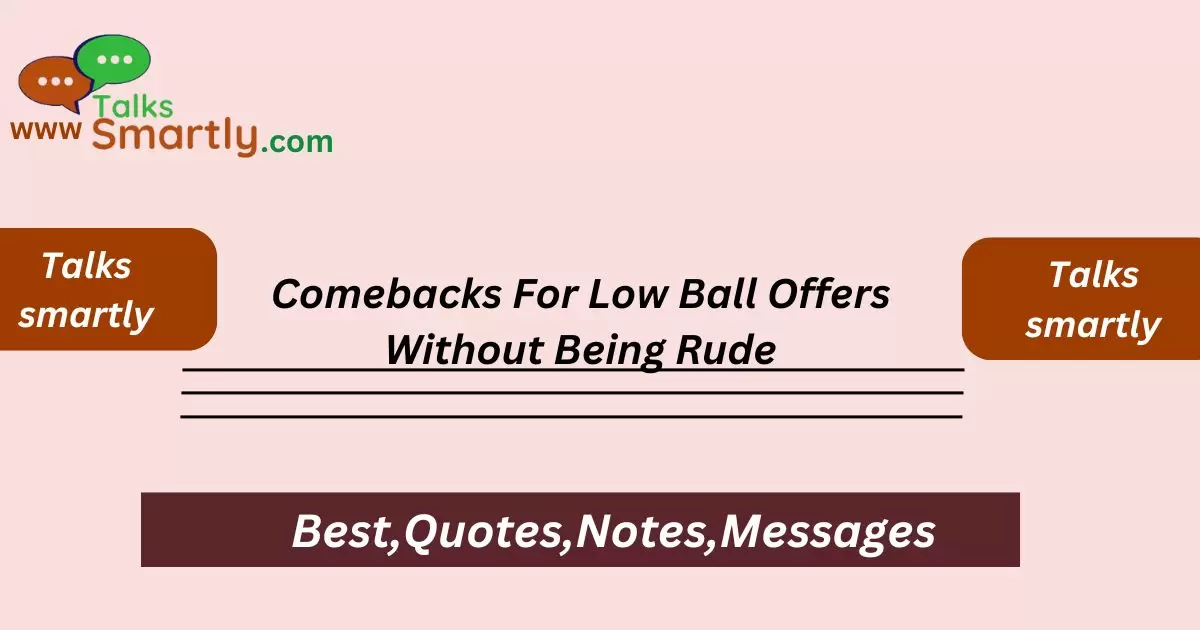Introduction
“In negotiations, responding to low ball offers tactfully is crucial. These diplomatic comebacks help maintain respect while striving for fair agreements.”
Navigating negotiations involving low ball offers requires finesse to maintain professional relationships while ensuring fair outcomes.
This article offers 110+ diplomatic responses tailored to help you handle such scenarios with tact and respect, fostering mutually beneficial agreements.
Comebacks For Low Ball Offers Without Being Rude
- “Thank you for your offer. Let’s discuss how we can reach a fair price that aligns with the value of [product/service].”
- “I appreciate your proposal. Let’s discuss how we can adjust the terms to better reflect the market value.”
- “While I understand your budget considerations, I believe [slightly higher price] is more in line with the quality and benefits of [product/service].”
- “Your offer is noted. I’m confident that [higher price] reflects the true worth of [product/service] based on [specific reasons].”
![I’m confident that [higher price] reflects the true worth of product/service based on specific reasons.](https://talkssmartly.com/wp-content/uploads/2024/07/im-confident-that-higher-price-reflects-the-true-worth-of-productservice-based-on-specific-reasons.webp)
- “I respect your offer. Here’s why I believe [higher price] provides a more comprehensive solution to your needs.”
- “I hear your perspective. Would you be open to [incremental increase] to ensure we meet both our expectations?”
- “Thank you for your interest. Let’s discuss how [higher price] can better address your requirements and expectations.”
- “Your offer is appreciated. Could we adjust to [slightly higher price] to better accommodate the features and benefits you value?”
- “I value your interest. Here’s why [higher price] not only meets but exceeds the standards you’re looking for.”
- “I understand your budget constraints. However, I firmly believe that [higher price] offers unparalleled long-term value and satisfaction.”
Focusing on Value
- “Investing in [product/service] ensures a significant return on investment due to its [specific benefits and features].”
- “The unique benefits of [product/service], such as [list of key features], clearly justify its pricing.”
- “Let me highlight the features that make [product/service] stand out and worth the investment you’re considering.”
- “The quality and reliability of [product/service] are unparalleled, making its price point a reflection of its superior value.”
- “Choosing [product/service] means securing [specific benefits], which are well worth the investment.”
- “Here’s how [product/service] compares favorably to alternatives in terms of [performance, durability, etc.].”
- “The longevity and efficiency of [product/service] make it a wise investment over cheaper alternatives.”
- “Investing in [product/service] not only solves immediate needs but also prepares for future growth and efficiency.”
- “The cost-effectiveness of [product/service] ensures long-term savings and enhanced operational efficiency.”
- “Here’s how [product/service] contributes to overall productivity and performance improvements.”
Counter Offers
- “I appreciate your offer. Would you consider meeting me at [counter offer] to proceed?”
- “Let’s find common ground by adjusting to [counter offer] that benefits both parties.”
- “Could we negotiate towards [incremental increase] to bridge the gap between our initial offers?”
- “Let’s discuss terms around [counter offer] to ensure we reach an agreement that satisfies both our expectations.”
- “I’m open to exploring options around [counter offer] to find a solution that meets our mutual interests.”
- “Here’s why I believe [counter offer] reflects the fair value of [product/service] based on current market conditions.”
- “Let’s aim for [counter offer] as a reasonable compromise that respects both our perspectives.”
- “I propose adjusting to [counter offer] to ensure we move forward with a mutually beneficial agreement.”
- “The additional value provided by [counter offer] justifies the slight adjustment in price.”
- “Here’s how [counter offer] aligns with your needs while maintaining the integrity of [product/service].”
Meeting in the Middle
- “Finding a compromise at [middle ground price] seems reasonable to ensure both sides benefit from this transaction.”
- “Can we agree on [price between offers] that reflects a fair balance of our respective perspectives?”
- “I propose [middle ground price] as a fair compromise that respects the value of [product/service] and your budget considerations.”
- “Let’s aim for [middle point] where both parties can feel satisfied with the outcome of our negotiations.”
- “Meeting at [balanced price] ensures we achieve a mutually beneficial agreement without compromising quality.”
- “Here’s how [middle ground price] allows us to maintain the quality and benefits of [product/service] while meeting your budget.”
- “The flexibility of [middle ground price] ensures a win-win situation for both parties involved.”
- “Choosing [middle ground price] means we can move forward with confidence in our agreement.”
- “I believe [middle ground price] strikes a fair balance between affordability and the value provided by [product/service].”
- “Here’s why I see [middle ground price] as a strategic decision that benefits both our interests.”
Bundling
- “To enhance your experience, consider bundling [additional item/service] with [product/service] to provide added value.”
- “Including [extra feature] in a package deal can justify the overall price and enhance the benefits you receive.”
- “I can offer a comprehensive package that includes [related product/service] to meet your needs more comprehensively.”
- “How about exploring a bundled offer that combines [product/service] with [additional item/service] for a holistic solution?”
- “Let’s discuss a bundle that not only fits your budget but also maximizes the benefits you receive.”

- “Here’s why bundling [additional item/service] with [product/service] makes financial sense and enhances your overall experience.”
- “The combined package of [product/service] and [additional item/service] offers a complete solution at a competitive price.”
- “Choosing our bundled offer ensures you receive comprehensive benefits at a cost-effective price point.”
- “Here’s how our bundled offer aligns with your requirements and provides a seamless solution to your needs.”
- “I believe our bundled offer represents a compelling value proposition that meets your budgetary considerations.”
Finding Compromise
- “Let’s work together to find a solution that accommodates both our needs, possibly adjusting to [slight adjustment] in terms.”
- “Can we discuss how [small tweak] can help us find common ground and move forward with our agreement?”
- “I’m open to exploring [specific adjustment] to ensure we reach a mutually satisfactory compromise.”
- “Let’s negotiate around [terms/conditions] to find a middle ground that satisfies both parties involved.”
- “Finding a compromise that addresses your budget concerns while respecting the value of [product/service] is our goal.”
- “Here’s why I see [specific adjustment] as a strategic move that benefits both parties involved.”
- “Choosing [specific adjustment] allows us to proceed with confidence in our agreement.”
- “The flexibility of [specific adjustment] ensures a mutually beneficial outcome for both parties.”
- “I believe [specific adjustment] reflects a fair compromise that respects both our perspectives.”
- “Here’s how [specific adjustment] allows us to maintain the integrity and quality of [product/service] while addressing your needs.”
Creative & Flirty Responses: How to Reply to “Good Morning”
Recommending Alternative Products Within Their Budget
- “If this item stretches your budget, I have other options that might fit better. Let’s explore what else could meet your needs.”
- “Considering your budget, I recommend [alternative product/service] which offers similar benefits at a more affordable price.”
- “Let’s discuss [alternative product/service] as a viable option that aligns with your financial constraints.”
- “Here’s an alternative that maintains the quality you’re looking for while fitting within your budget.”
- “I suggest exploring [alternative product/service] which provides a cost-effective solution without compromising on quality.”
- “If you’re open to other options, I can recommend [alternative product/service] that meets your needs and budget.”
- “Let’s consider [alternative product/service] as a practical alternative that balances affordability and quality.”
- “Here’s why [alternative product/service] is a suitable choice that offers excellent value within your budget.”
- “Choosing [alternative product/service] ensures you get the most out of your investment while staying within your financial limits.”
- “I recommend [alternative product/service] as a smart choice that meets your requirements without exceeding your budget.”
Politely Declining the Offer with Gratitude
- “Thank you for your offer. At this time, I must respectfully decline.”
- “I appreciate your interest. However, I’m unable to accept your current offer.”
- “Thank you for considering me. Unfortunately, I must decline your proposal.”
- “I’m grateful for your offer, but I must politely decline.”
- “While I appreciate your offer, I regretfully cannot accept it.”
- “Thank you for thinking of me. I must decline your offer at this time.”
- “I’m flattered by your offer, but I must decline with gratitude.”
- “I appreciate your thoughtfulness. However, I must decline this offer respectfully.”
- “Thank you for the opportunity. Unfortunately, I must decline your offer.”
- “I value your interest. However, I must respectfully decline your offer at this time.”
Assert Your Worth
- “I believe in the value of [product/service] and stand by its worth.”
- “I’m confident that [higher price] accurately reflects the quality and benefits of [product/service].”
- “I firmly believe that [higher price] represents the true value of [product/service] in today’s market.”
- “The price of [product/service] is a reflection of its unmatched quality and reliability.”
- “Choosing [product/service] means investing in top-tier quality and performance.”
- “I’m committed to delivering exceptional value through [product/service] at a fair price.”
- “I stand behind the value proposition of [product/service] and its benefits.”
- “Here’s why the price of [product/service] is justified based on its features and benefits.”
- “The cost of [product/service] ensures you receive the best value for your investment.”
- “I assure you that [higher price] is justified by the unparalleled benefits of [product/service].”
Educate on Fair Market Value
- “Let’s discuss how [fair market value] is determined and why it’s important in this context.”
- “Understanding [fair market value] helps us negotiate effectively and fairly.”
- “Here’s why [fair market value] plays a crucial role in pricing [product/service].”
- “Let me explain how [fair market value] impacts the pricing of [product/service] in the current market.”
- “Educating ourselves on [fair market value] ensures transparency and fairness in our negotiations.”
- “Here’s how knowing [fair market value] helps us arrive at a mutually agreeable price.”
- “Understanding the concept of [fair market value] ensures we reach a fair and equitable agreement.”
- “Let’s align on [fair market value] to ensure our negotiations are based on accurate pricing.”
- “I’m here to provide insights into [fair market value] and its relevance to [product/service].”
- “Here’s how [fair market value] reflects the true worth of [product/service] in today’s economic landscape.”
Invite Reevaluation
- “Let’s take another look at the factors influencing the pricing of [product/service].”
- “I encourage you to reconsider [higher price] based on the value and benefits provided.”
- “Here’s why revisiting [higher price] could lead to a more mutually beneficial outcome.”
- “Let’s review [specific aspects] to see how they justify the price of [product/service].”
- “I invite you to reassess [higher price] in light of the advantages and benefits offered.”
- “Reevaluating [higher price] may reveal additional value and benefits you hadn’t considered.”
- “Let’s revisit [higher price] to ensure it accurately reflects the quality and performance of [product/service].”
- “I encourage a fresh look at [higher price] to appreciate its true value in today’s market.”
- “Here’s why reconsidering [higher price] is beneficial for both parties involved.”
- “Let’s reevaluate [higher price] to ensure it aligns with your expectations and the market standards.”
Emphasize Quality and Benefits
- “The superior craftsmanship of [product/service] ensures durability and long-term satisfaction.”

- “Choosing [product/service] guarantees premium quality, backed by positive customer reviews.”
- “Here’s how [product/service] excels in performance, providing unmatched value for your investment.”
- “I emphasize the innovative features of [product/service], designed to meet your specific needs.”
- “Investing in [product/service] means enjoying advanced technology and reliable functionality.”
- “Here’s why [product/service] stands out with its user-friendly design and ease of use.”
- “Choosing [product/service] ensures you benefit from industry-leading standards and certifications.”
- “I’m confident in the exceptional benefits [product/service] offers, making it a wise investment.”
- “Here’s how [product/service] enhances productivity and efficiency, delivering tangible results.”
- “The comprehensive warranty and customer support for [product/service] reflect our commitment to quality and customer satisfaction.”
Negotiate with Professionalism
- “Maintain open communication and listen actively to understand each other’s perspectives.”
- “Approach negotiations with a collaborative mindset, seeking win-win solutions.”
- “Express appreciation for the offer while respectfully advocating for fair terms.”
- “Clarify expectations and timelines to ensure clarity and mutual understanding.”
- “Propose creative solutions that address both parties’ interests and concerns.”
- “Avoid personal attacks or aggressive language; focus on the facts and benefits.”
- “Stay patient and composed, even if negotiations become challenging.”
- “Seek common ground and compromise where possible to reach a mutually beneficial agreement.”
- “Keep the negotiation process transparent and maintain integrity throughout.”
- “End negotiations on a positive note, regardless of the outcome, to preserve relationships for future opportunities.”
Final Words
Navigating low ball offers requires finesse and strategic communication. By employing the 110+ diplomatic responses outlined in this article, you can effectively manage negotiations while maintaining respect and professionalism.
Each interaction presents an opportunity to build trust and cultivate positive relationships, ensuring mutually beneficial outcomes in business and personal transactions.
In conclusion, handling low ball offers with diplomacy and tact is essential for fostering positive negotiations. By focusing on value, proposing counter offers, finding compromises, and emphasizing professionalism, you can navigate these situations with confidence and achieve fair agreements.
Remember to assert the worth of your product or service, educate on fair market value, and invite reevaluation to facilitate constructive discussions. With these strategies, you can turn challenging negotiations into opportunities for mutual understanding and beneficial outcomes.












